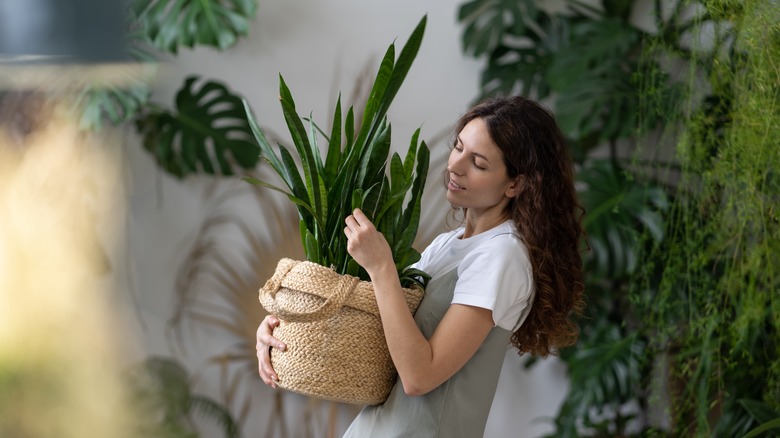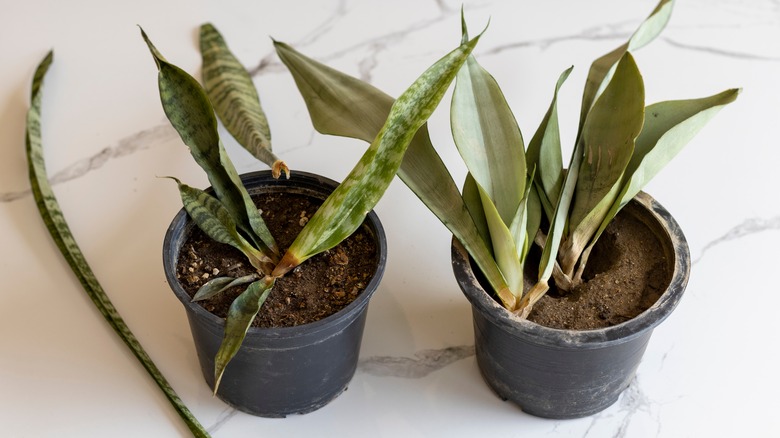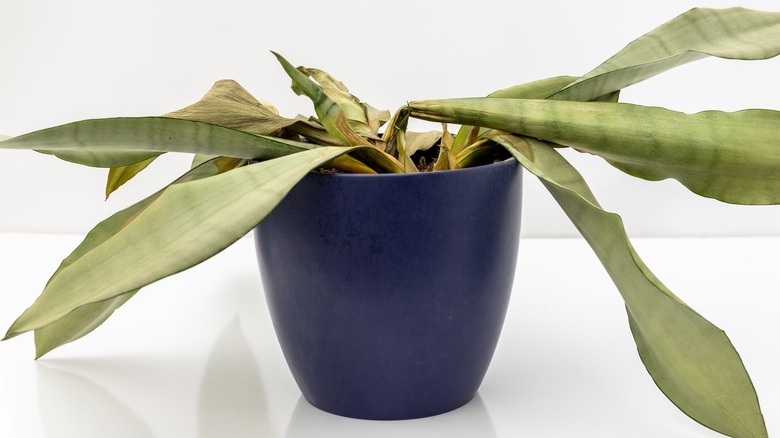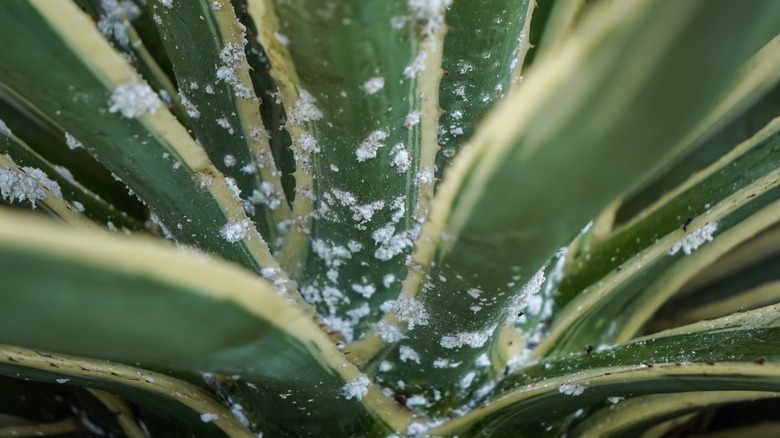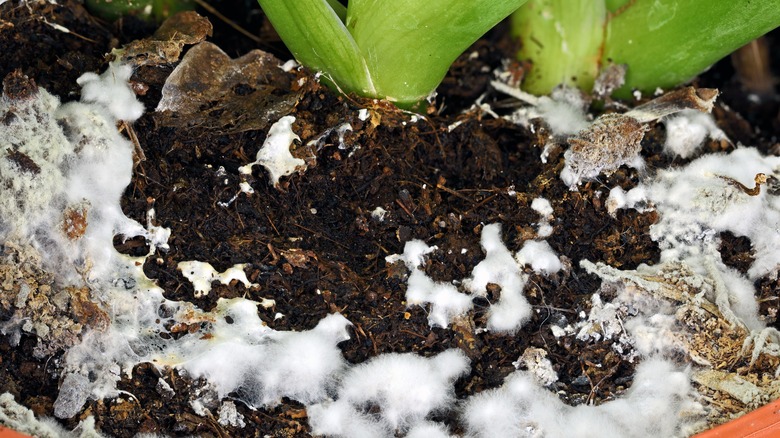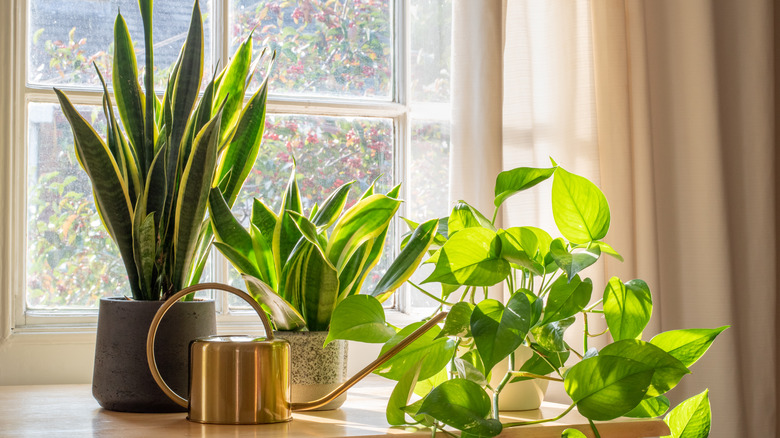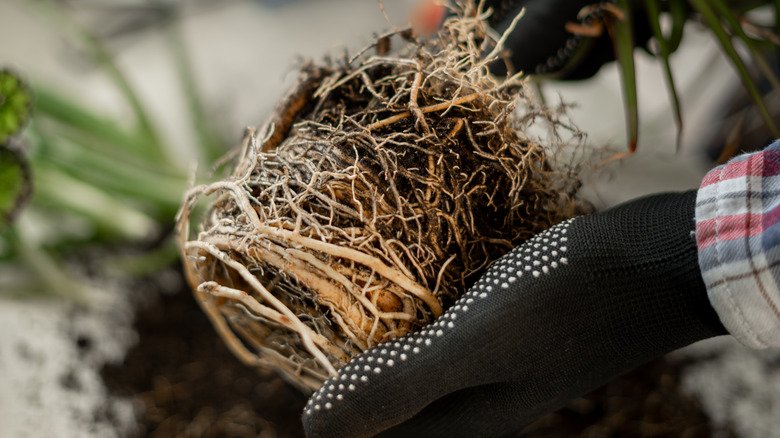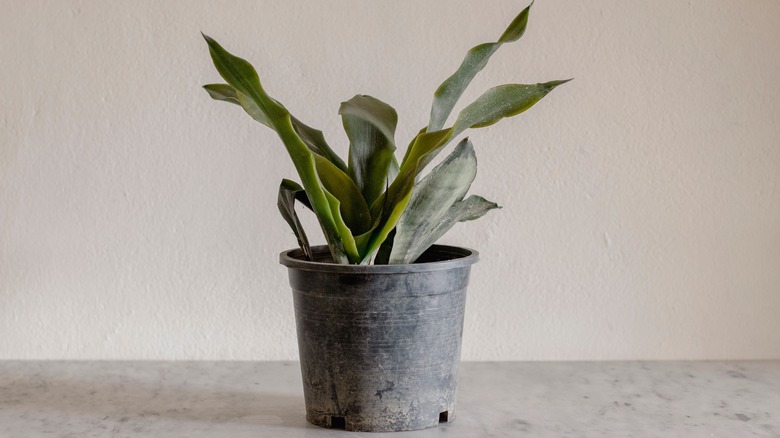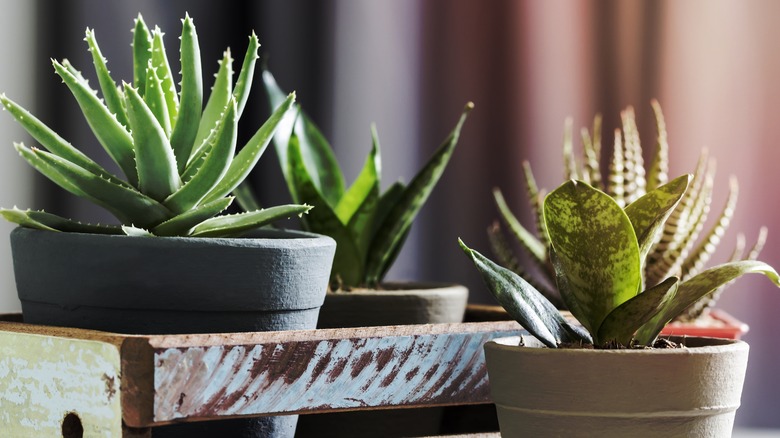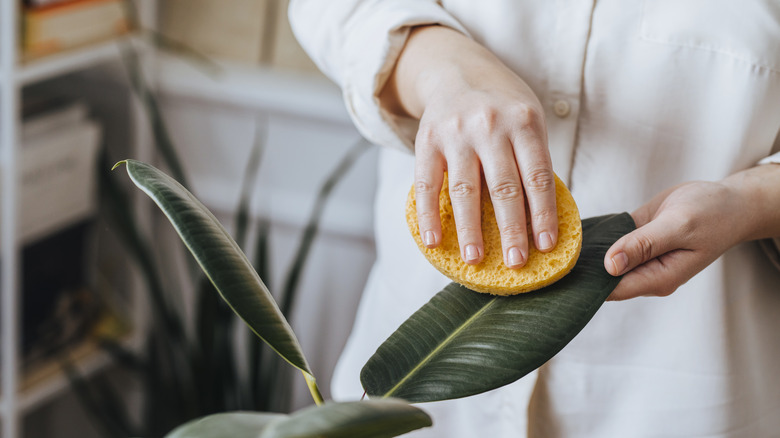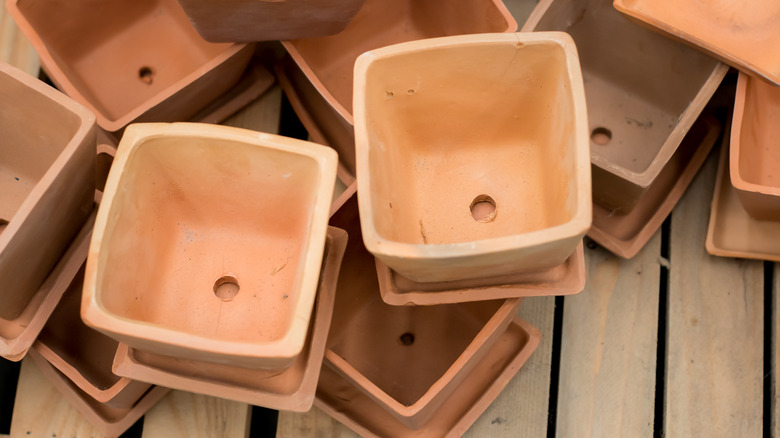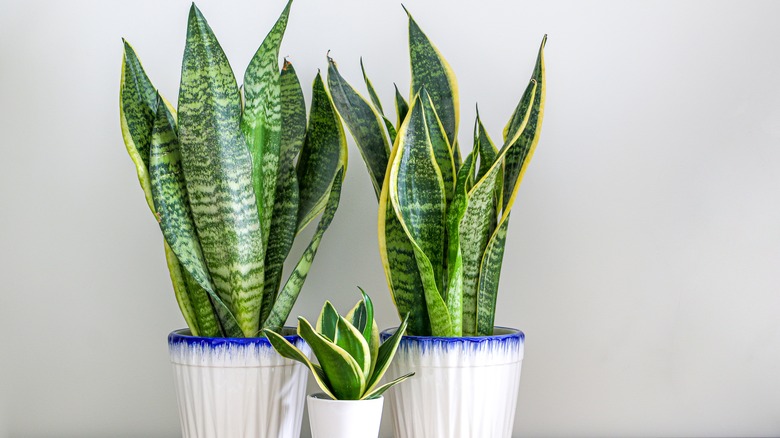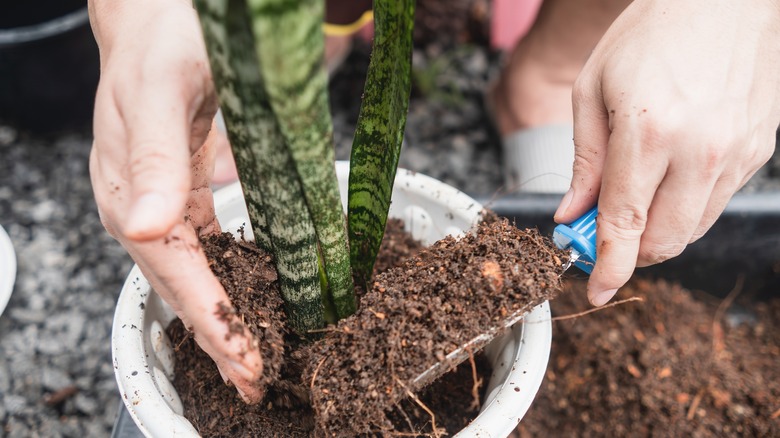The Ultimate Guide To Saving A Dying Snake Plant
Snake plants (Sansevieria trifasciata) are popular indoor plants known for their resilience. They are fan favorites for their striking leaves and air purifying benefits, making them popular for bedrooms. While snake plants are known as a beginner plant since they are relatively easy to take care of, there are still a multitude of things that can go wrong. Especially if you're a new plant parent, you might think that when the leaves go brown, it's time to throw it away, but there are many tips and tricks for resurrecting a snake plant.
One difficult aspect of plant care is that your plant's symptoms can often have many causes. The leaves will turn yellow and droopy, but you won't know what the culprit is. To help you figure out the problem and save your snake plant, we've assembled a list of the top 12 most common reasons your plant is dying, and a step by step guide to saving it.
You're overwatering the plant
Everyone knows a plant needs water to live, and if you see your plant starting to decline, you might feel tempted to add a whole can of water in hopes of saving it. While this might work for other types of flora, the snake plant is native to West Africa, which has a naturally arid environment. Not needing a lot of water is part of what makes this plant hardy, but this makes knowing how much it needs and when complicated. To figure out if your plants' yellowing leaves are due to overwatering, check the stem and roots. A soft and mushy stem is the biggest indicator that the plant has more moisture than it can handle. If the roots are starting to rot, that is another indicator that there is an excess of water with nowhere to go.
The trick is to let the soil dry out in between waterings. Rather than blindly sticking to a watering schedule, you should test the plant's soil to see how moist or dry it is. Stick a finger 1 to 2 inches into the soil. If it comes out dry, then you are good to water it. If it is damp, wait a few days to allow the plant to fully absorb all the moisture before adding more. If the roots have rotted, then you should repot the plant in a vessel with proper drainage and fresh soil to give it the best chance of bouncing back.
You're underwatering the plant
On the other hand, some might think that because the snake plant isn't known to die easily, it doesn't require much water and needs little tending to (if any). However, not providing your plant with adequate watering will also cause it to die. To figure out if you are overwatering, take a look at your plant and touch its leaves. If the leaves have started to curl, it's a big indication that the plant isn't getting the hydration it needs to thrive. If they are dry and brittle to the touch, breaking off easily into your hand, your plant is definitely under watered. You want the leaves to be strong and supple, able to bend without breaking.
To find the right balance between overwatering and underwatering, stick to the previously mentioned trick. If you poke a finger into the soil and it feels dry, give it enough water to dampen the soil but not so much that an excess puddle accumulates in the pot. You don't want to stick to a regular watering schedule because how quickly a snake plant dries out will depend on the season and conditions, so checking in with the plant regularly and adjusting to its needs will keep it thriving. And if your plant is already dried out, don't be discouraged or overwater it to compensate for this. Just start watering it correctly and your plant may make a full recovery.
There are pests on the plant
Seeing an infestation of tiny bugs on your plant is gross, and you might immediately reach for the trash can so the pests don't spread to any of your other plants. But there are some simple and easy ways to eliminate these pests without harming your plant. Spider mite and mealybug infestations are among the most common in snake plants. These bugs extract sap from snake plant leaves, and their sticky secretions can attract mold. Sometimes, these bugs are so small they look like spots of discoloration, but giveaways like their webs and sticky residue will alert you their unwanted presence.
Using insecticidal soap is a safe and effective method of eliminating these bugs quickly. Many insecticidal soaps, like this Garden Safe one from Home Depot, are sold in convenient spray bottles. Instead of scrubbing with water, you can simply spray the solution everywhere on the plant, including the underside of leaves, and repeat as needed. You can also use Neem oil as an organic pesticide, which can kill and repel insects. However, if you have a large infestation of mature bugs, this might not be as effective.
The plant has fungal disease
Detecting a fungal disease in a snake plant can be challenging because many of its symptoms can overlap with other issues like overwatering, pests, or nutrient deficiencies. Yellowed leaves can occur with both fungal diseases and overwatering, but with fungal diseases, you may notice that it occurs more rapidly. Fungal infections can cause dry or slimy dark spots on leaves, which may spread over time. Rotting stems are also common. The clearest indicator is that fungi produce visible signs of infection such as powdery white mildew or fuzzy mold on the leaves or soil surface. If you notice this unusual change in your plant's texture, it's time to spring into action and get rid of the fungus.
To treat your plant, remove any affected leaves or stems and reduce watering to prevent further spread of the fungus. Fungus thrives in damp environments, so if you've been overwatering your plant, it may have developed fungus as well. You will want to reduce moist breeding grounds to prevent it from spreading. This includes using well-draining soil and providing adequate air circulation. You can try some DIY fungus removal tricks, but if the problem persists after you've provided appropriate growth conditions, consider using a fungicide. Many fungicide formulas are available in spray bottles at gardening or home improvement stores. This makes it easy to spray around the plant until the fungus has been eliminated.
The leaves are sunburned
Aren't plants supposed to be out in the sun? They can't possibly be sunburned, right? These are some questions you might be asking yourself when looking at the mysterious yellow or brown patches on your snake plant's leaves. The short answer is yes, plants can get sunburned if they are exposed to too much direct sunlight, especially during peak sunlight hours. This can result in discolored or bleached and faded leaves. In severe cases, the affected leaves may become dry and brittle until eventually, they die. If your snake plant is looking lackluster, dry, and paler than usual, sunburn might be the culprit.
To return your plant to its original vibrancy and health, simply move the plant to a shadier location to prevent further damage. Snake plants prefer bright, indirect sunlight. If your snake plant is in a spot with direct sunlight and you can't change the location, try to rotate it regularly to ensure that all sides receive equal amounts of light, thus reducing the likelihood of sunburn. If your snake plant has already experienced sun damage, you can prune away the affected leaves to encourage new, healthy growth.
The plant has become root bound
When a plant's roots have grown to fill up its pot completely, leaving no room for further growth, it's considered root bound. The roots become tightly packed and entangled, inhibiting the plant's ability to absorb water and nutrients. This can lead to stunted growth and other issues. A root bound plant will not necessarily die as a result, but it will struggle to absorb water and nutrients effectively due to its limited space. The tightly packed roots won't absorb as much water, causing the soil to become waterlogged. This can lead to root rot and fungal disease, all of which may kill your plant.
A root bound plant may show signs of slow growth with smaller leaves. You may see roots growing out of the drainage holes at the bottom of the pot, or they may be visible at the surface of the soil. If you suspect that your snake plant is root bound, it's essential to repot it to allow the roots to grow and spread. Choose a pot that is one size larger than the current pot and use fresh potting soil. Gently remove the plant from its current pot, loosen the roots, and place it in the new pot. Fill in the space around the roots with fresh soil and water. Soon, your plant should grow into its new home and return to its proper health.
It has a nutrient deficiency
Just like humans, plants can't grow if they don't have the proper nutrients. While water and sunlight are often enough to keep a plant healthy, sometimes, your plant needs a little boost. The yellowing of a plant's leaves, known as chlorosis, is a common symptom of nutrient deficiencies. It is also a common symptom of overwatering, fungal disease, and more. The leaves may turn yellow overall or show yellowing between the veins. With a nutrient deficiency, the leaves may curl or cup, often downward and at the edges. The telltale sign that your plant has a nutrient deficiency as opposed to another malady is slow growth in its overall size as well as the size of its new leaves or stems.
For an extra boost, use a fertilizer intended for indoor plants. Nitrogen, phosphorus, and potassium are essential nutrients plants need to thrive and the most common ingredients in fertilizer. For the best results, lightly fertilize houseplants during their growing season, which typically spans from early spring to late summer and avoid fertilizing during the winter. This is when the plants are actively growing and will most effectively utilize the added nutrients. You can use a store bought fertilizer or items you might already have at home, like coffee grounds or banana peels.
Humidity levels are off
Depending on where you live, your snake plant may suffer from either too much or not enough humidity in its environment. Because snake plants are native to West Africa, they typically prefer moderate humidity. If your plant's leaves have brown tips and feel dry or brittle to the touch but you know you are watering it correctly, it might need that extra boost of humidity in its environment. Issues caused by low humidity are especially common during winter when indoor heating systems are in use. However, while snake plants can tolerate moderate to high humidity, excessively high levels combined with poor air circulation can create a breeding ground for fungal diseases.
Increase the humidity in your home by placing a humidifier near the plant. You should aim for a relative humidity level of around 50%, which is comfortable for most houseplants, including snake plants. If you want to get really serious, use a humidity gauge (hygrometer) to monitor humidity levels. You can also achieve a similar effect by grouping plants together to create a microclimate with higher humidity. To avoid excess humidity in your home, ensure proper air circulation by opening windows or using fans. Maintaining a proper humidity level in your home will not only benefit your plants, but it will benefit you, too.
Its leaves are dusty
Dusty leaves themselves are not likely to kill a snake plant, but if left unaddressed, the accumulated dust can have negative effects on the plant's health. Dust on the leaves can affect the plant's ability to take in carbon dioxide and release oxygen. This can interfere with the plant's ability to carry out photosynthesis, which is essential for its growth and overall health. Dust can attract pests, such as spider mites, which feed on the dust particles and can potentially harm the plant if their population grows unchecked.
No matter how much you clean, dust in a home is inevitable, especially if the plant is on the floor or in a corner where dust will naturally accumulate. Luckily, there is a quick fix. Simply grab a damp cloth or sponge and gently wipe the leaves to rid the plant of any dust. Alternatively, you can periodically place the plant in the shower and gently rinse the leaves with lukewarm water. Make sure to avoid using any cleaning products or soap on the leaves, which may harm the plant. When the dust is clear, your plant will instantly go back to breathing normally.
Its pot has poor drainage
Choosing a pot solely based on which has the prettiest design may feel tempting, but placing your plant in the wrong vessel can lead to many problems, including killing it. If your plant has droopy, soggy leaves that turn yellow, you should first inspect your pot. Turn it upside down and look for drainage holes in the bottom. A pot with proper drainage should have one or more holes to allow excess water to escape. If you're still unsure, water your snake plant thoroughly and observe. If water is pooling on top of the soil or taking a long time to drain, your pot probably doesn't have proper drainage.
The easiest solution for this is to transfer your plant to a container with proper drainage. Make sure the new pot is slightly larger than the current one and has drainage holes. If you can't part with your favorite decorative pot, you can drill holes in the bottom of it to allow water to drain from it. Use a drill with a masonry bit for ceramic or clay pots and a regular bit for plastic pots. Be sure to wear safety goggles and gloves. Or, you can repot your plant in a container with proper drainage and use the decorative pot without drainage as a cache pot. This is a great solution for those who don't like the look of saucers but still need to add proper drainage so their plant can bounce back to life.
There isn't enough sunlight
Sunlight is essential to plants because it provides the energy necessary for photosynthesis, a process through which plants convert light energy into chemical energy. Without it, there is nothing to fuel the plant's growth and development. Insufficient sunlight can cause the leaves to pale and lose their vibrancy, while the plant's new growth may appear weaker. The snake plant does not thrive in harsh direct sunlight, which can result in sunburned leaves — but it can't thrive in complete shade either.
Moving the plant to an area with indirect or filtered sunlight should be the perfect medium. This means they should be placed near a window where they can receive bright light, but they should not be exposed to direct sunlight for prolonged periods, especially during the hottest part of the day. Pay attention to the tag when you are buying a new snake plant because different variations do require different levels of sun exposure. While snake plants can tolerate low light conditions, they may grow more slowly and have less vibrant foliage.
The soil is wrong for the plant
You might think that dirt is one size fits all, especially if you buy a fancy potting mix from the gardening store. But if you have your snake plant in the wrong soil, it might cause drainage issues or have the wrong pH. A soil that doesn't drain well will cause problems like root rot and fungus infections. If your soil is too acidic, you will see discolored leaves curling inward and stunted growth.
You should first test the pH of your soil, with or without a kit. Snake plants prefer a slightly acidic to neutral soil pH, so aim for a mix that is pH balanced (around 5.5 to 7.0) to ensure that your snake plant can absorb nutrients effectively. You can either buy new soil or add dolomitic lime (also known as garden lime) to raise the pH if necessary. This is a mineral that is widely used in gardening to raise the pH of acidic soils. It supplies essential calcium and magnesium. You can buy it at any home improvement store.
You want a soil that drains well, which will prevent overwatering and root rot. You can either buy a premade soil mix or create your own by adding wood chips, pumice, clay pebbles or other drainage materials. This will create a loose, fast-draining soil with air pockets where roots can grow. The right soil will provide your plant with a new home where it can grow back to life!

